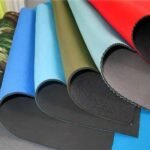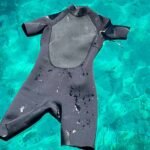Neoprene swimwear is becoming an increasingly popular choice for water sports enthusiasts and fashion-forward swimmers. Known for its unique properties, neoprene offers both comfort and functionality in a way that traditional swimwear fabrics simply can’t match. Whether you’re creating a new swimwear line or simply exploring the material, understanding what neoprene swimwear is, its benefits, and its limitations will help you make informed decisions. In this article, we’ll answer all the key questions surrounding neoprene swimwear and explore why it’s such a game-changer in the industry.
Neoprene swimwear is made from a synthetic rubber material known for its flexibility, insulation properties, and resistance to water. It’s commonly used in wetsuits, but it’s gaining popularity in swimwear due to its unique benefits for active swimmers and those who enjoy outdoor water activities. What is neoprene fabric made of?
To fully understand the advantages of neoprene swimwear, it’s essential to start with the basics—what exactly is neoprene, and why has it become so popular for swimwear in particular?
What is a Neoprene Swimsuit?
A neoprene swimsuit is a type of swimwear made from the same material used in wetsuits, commonly worn by divers, surfers, and other water sport enthusiasts. Neoprene is a synthetic rubber material known for its flexibility and its ability to retain warmth in cold water, making it ideal for swimsuits meant for colder environments. Neoprene swimwear can range from full-body suits to more traditional swimwear cuts, offering both style and function. What are the advantages of neoprene?
Neoprene swimwear provides excellent thermal insulation, flexibility, and comfort, making it a top choice for anyone participating in water sports or simply looking for a more supportive, comfortable swimsuit option.
Neoprene is not just about warmth—it’s about comfort and performance. It has a unique stretchability that allows for ease of movement, making it particularly suited for active wear. Additionally, neoprene swimsuits often feature a sleek, modern look and can be custom-designed for a perfect fit, making them a go-to choice for custom swimwear lines. The material also has shock-absorbing qualities, providing more support to the wearer while swimming, which is especially important for those engaging in rigorous water activities. What is neoprene used for in swimwear?
What Are the Disadvantages of Neoprene?
While neoprene offers many benefits, it’s important to understand its limitations to make an informed decision when choosing swimwear. Although neoprene is a durable and versatile material, there are certain downsides to be aware of, especially when considering it for swimwear.
The main disadvantages of neoprene swimwear include its potential to trap heat in hot weather, the need for proper care to maintain its elasticity, and its heavier weight compared to traditional swimwear fabrics.
One of the key drawbacks of neoprene swimwear is its inability to breathe as well as other fabrics like Lycra or polyester. Because it traps air and moisture between the layers, it can become uncomfortable in very hot weather or if you’re swimming for extended periods in warm water. Neoprene also tends to be heavier and less flexible than lighter materials, which might limit its use for those looking for a more lightweight, minimalist swimsuit. Additionally, neoprene requires careful maintenance—failure to rinse it properly after use or store it in direct sunlight can damage the material, causing it to lose its elasticity or color. What are the disadvantages of neoprene?
What Type of Fabric is Neoprene?
Neoprene is a type of synthetic rubber, primarily made from polychloroprene. It’s a closed-cell foam material that is highly durable and water-resistant, making it ideal for swimwear that needs to withstand exposure to water and stretch. But what sets it apart from other fabrics commonly used in swimwear?
Neoprene is a durable synthetic rubber that provides a unique blend of flexibility, insulation, and water resistance, making it superior to traditional swimwear fabrics like Lycra or Spandex when it comes to performance and protection in water. What type of fabric is neoprene?
Neoprene fabric is created by polymerizing chloroprene monomers to form a thick, flexible foam. The material is closed-cell, meaning it doesn’t absorb water, which is essential for swimwear used in cold-water activities. Neoprene’s insulation properties allow it to maintain body warmth, which is why it’s a common choice for wetsuits. Additionally, neoprene is highly customizable—it can be made in varying thicknesses and stiffness levels to suit different needs, from lightweight performance suits to thick, insulating suits for colder water.
Why Should You Choose Neoprene for Your Swimwear Line?
Neoprene has several advantages over traditional swimwear materials, especially for brands looking to offer something unique to their customers. Its exceptional performance in water, along with its ability to be customized, makes it a great choice for high-quality swimwear.
Choosing neoprene for your swimwear line offers many benefits, including enhanced comfort, thermal insulation, durability, and the ability to create custom designs that stand out in the market.
For swimwear brands, neoprene provides a competitive edge. The material’s water resistance and thermal insulation make it ideal for colder climates, providing an additional layer of warmth and comfort for wearers. Neoprene’s flexibility and stretchiness ensure that it fits snugly, offering better support than traditional materials. From a design perspective, neoprene swimwear can be customized in a variety of ways—whether you’re creating sleek, modern cuts or more complex, performance-driven designs. This level of customization is perfect for brands aiming to cater to different customer needs, from professional athletes to leisure swimmers. Additionally, neoprene swimwear is durable and resistant to chlorine and saltwater, making it a long-lasting option for customers who swim frequently. Why is neoprene a good material for swimwear?
Which Styles of Swimwear Can Be Made from Neoprene?
One of the major benefits of neoprene is its versatility in design. From full-body wetsuits to bikini tops, neoprene can be used to create a wide variety of swimwear styles that combine style, comfort, and performance.
Neoprene can be used to make a range of swimwear styles, including full-body suits, one-piece swimsuits, bikinis, and even activewear like rash guards and swim shorts.
Neoprene is a popular choice for swimwear styles designed for active water sports. Full-body wetsuits provide maximum coverage and insulation for water activities like surfing or diving, while one-piece swimsuits made from neoprene offer excellent flexibility and support. For a more fashionable approach, neoprene bikinis and swim tops combine the material’s unique texture with trendy designs, giving swimmers a stylish option for lounging or swimming. Neoprene is also used for rash guards and other performance swimwear, as it helps with movement, comfort, and temperature regulation. Custom swimwear brands can create tailored pieces to suit their target audience’s needs, from those looking for warmth in cold water to those needing more mobility in warmer conditions.
Conclusion
Neoprene swimwear is a versatile and high-performance material that is quickly becoming a favorite among swimmers and water sports enthusiasts alike. Whether you’re looking for added thermal insulation, flexibility, or a unique design, neoprene offers it all. While there are some considerations to keep in mind, such as its weight and care requirements, neoprene’s benefits far outweigh its drawbacks. For brands looking to expand their swimwear collections, neoprene is an excellent choice that offers both comfort and performance.
At Szoneier, we specialize in custom neoprene swimwear tailored to your brand’s specific needs. From wetsuits to bikinis, our team can help bring your designs to life with flexible customization options and a commitment to quality.
For more information or to request a quote, contact us today at info@neoprene-bag.com or visit our website at www.neoprene-bag.com.











